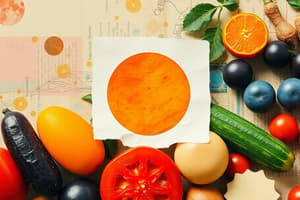Podcast
Questions and Answers
Which factor does NOT decrease the synthesis of vitamin D?
Which factor does NOT decrease the synthesis of vitamin D?
- Sun exposure in the morning (correct)
- Wearing sunscreen
- Long winter season
- Age
What role does vitamin D play in the body?
What role does vitamin D play in the body?
- It boosts appetite significantly
- It promotes fast weight loss
- It helps in the proper utilization of calcium and phosphorus (correct)
- It synthesizes collagen for skin health
Which of the following is a disease associated with vitamin D deficiency?
Which of the following is a disease associated with vitamin D deficiency?
- Muscular dystrophy
- Rheumatoid arthritis
- Osteoporosis
- Osteomalacia (correct)
What is the recommended daily intake of vitamin D for individuals aged 71 and older?
What is the recommended daily intake of vitamin D for individuals aged 71 and older?
What is NOT a symptom of vitamin D toxicity?
What is NOT a symptom of vitamin D toxicity?
What is one of the functions of Vitamin E?
What is one of the functions of Vitamin E?
Which group is at high risk for Vitamin E deficiency?
Which group is at high risk for Vitamin E deficiency?
What is the recommended daily intake of Vitamin K for men?
What is the recommended daily intake of Vitamin K for men?
What is a known deficiency symptom of Vitamin K?
What is a known deficiency symptom of Vitamin K?
Which food source is high in Vitamin E?
Which food source is high in Vitamin E?
What occurs in cases of Vitamin E toxicity?
What occurs in cases of Vitamin E toxicity?
What is the primary function of Vitamin D?
What is the primary function of Vitamin D?
How is Vitamin D primarily obtained?
How is Vitamin D primarily obtained?
What is a characteristic symptom of Wernicke Korsakoff syndrome?
What is a characteristic symptom of Wernicke Korsakoff syndrome?
Which food source is rich in riboflavin?
Which food source is rich in riboflavin?
What deficiency disease is characterized by the four 'Ds'?
What deficiency disease is characterized by the four 'Ds'?
What is one of the common symptoms of riboflavin deficiency?
What is one of the common symptoms of riboflavin deficiency?
Which of the following is NOT a symptom associated with Wernicke Korsakoff syndrome?
Which of the following is NOT a symptom associated with Wernicke Korsakoff syndrome?
What is one of the primary functions of folate (B9)?
What is one of the primary functions of folate (B9)?
What is the recommended daily intake of riboflavin for women?
What is the recommended daily intake of riboflavin for women?
Which vitamin contributes to the conversion of tryptophan to niacin and serotonin?
Which vitamin contributes to the conversion of tryptophan to niacin and serotonin?
What can a deficiency in folate lead to?
What can a deficiency in folate lead to?
What is the daily recommended intake of folate for adults?
What is the daily recommended intake of folate for adults?
What is the primary function of vitamins in the body?
What is the primary function of vitamins in the body?
Which vitamins are classified as fat-soluble?
Which vitamins are classified as fat-soluble?
What condition can arise from a deficiency of Vitamin B12?
What condition can arise from a deficiency of Vitamin B12?
How are water-soluble vitamins absorbed in the body?
How are water-soluble vitamins absorbed in the body?
Which statement about the absorption of Vitamin B12 is correct?
Which statement about the absorption of Vitamin B12 is correct?
What kind of anemia is associated with folate deficiency?
What kind of anemia is associated with folate deficiency?
What is a characteristic of fat-soluble vitamins regarding excretion?
What is a characteristic of fat-soluble vitamins regarding excretion?
Which of the following statements about vitamin intake frequency is true?
Which of the following statements about vitamin intake frequency is true?
What is one of the primary functions of Vitamin C?
What is one of the primary functions of Vitamin C?
What does folate help synthesize in the body?
What does folate help synthesize in the body?
What is the likelihood of toxicity from water-soluble vitamins?
What is the likelihood of toxicity from water-soluble vitamins?
What are typical signs of Vitamin C deficiency?
What are typical signs of Vitamin C deficiency?
At what dosage can toxicity symptoms for Vitamin C appear?
At what dosage can toxicity symptoms for Vitamin C appear?
Which of the following describes how fat-soluble vitamins travel in the body?
Which of the following describes how fat-soluble vitamins travel in the body?
Which vitamin is NOT considered water-soluble?
Which vitamin is NOT considered water-soluble?
Which of the following vitamins is part of the B complex?
Which of the following vitamins is part of the B complex?
What is a common food source for Thiamin B1?
What is a common food source for Thiamin B1?
What deficiency disease is associated with a lack of Thiamin B1?
What deficiency disease is associated with a lack of Thiamin B1?
Flashcards
What factors decrease vitamin D synthesis?
What factors decrease vitamin D synthesis?
Wearing sunscreen, dark skin, clothing, and prolonged indoor time are all factors that decrease the body's production of vitamin D.
What are the deficiency diseases associated with a lack of vitamin D?
What are the deficiency diseases associated with a lack of vitamin D?
Vitamin D deficiency in children can lead to rickets, a condition causing weak, malformed bones. Adults may experience osteomalacia, characterized by soft and deformed bones.
How is vitamin D synthesized in the body?
How is vitamin D synthesized in the body?
Our bodies produce vitamin D when our skin is exposed to sunlight. 30 minutes of sun exposure to the arms and legs is sufficient to increase blood levels of vitamin D.
What are the key functions of vitamin D?
What are the key functions of vitamin D?
Signup and view all the flashcards
What are the sources of vitamin D?
What are the sources of vitamin D?
Signup and view all the flashcards
What is an antioxidant?
What is an antioxidant?
Signup and view all the flashcards
What are the other benefits of Vitamin E?
What are the other benefits of Vitamin E?
Signup and view all the flashcards
Where is Vitamin E found?
Where is Vitamin E found?
Signup and view all the flashcards
What are the risks of Vitamin E deficiency?
What are the risks of Vitamin E deficiency?
Signup and view all the flashcards
What are the functions of Vitamin K?
What are the functions of Vitamin K?
Signup and view all the flashcards
Where does Vitamin K come from?
Where does Vitamin K come from?
Signup and view all the flashcards
What happens if the body lacks Vitamin K?
What happens if the body lacks Vitamin K?
Signup and view all the flashcards
What is Vitamin D?
What is Vitamin D?
Signup and view all the flashcards
Vitamin C (Ascorbic Acid)
Vitamin C (Ascorbic Acid)
Signup and view all the flashcards
Scurvy
Scurvy
Signup and view all the flashcards
Thiamin (Vitamin B1)
Thiamin (Vitamin B1)
Signup and view all the flashcards
Beriberi
Beriberi
Signup and view all the flashcards
B-Complex Vitamins
B-Complex Vitamins
Signup and view all the flashcards
Niacin (Vitamin B3)
Niacin (Vitamin B3)
Signup and view all the flashcards
Folate (Vitamin B9)
Folate (Vitamin B9)
Signup and view all the flashcards
Cobalamin (Vitamin B12)
Cobalamin (Vitamin B12)
Signup and view all the flashcards
What are vitamins?
What are vitamins?
Signup and view all the flashcards
What are fat-soluble vitamins?
What are fat-soluble vitamins?
Signup and view all the flashcards
What are water-soluble vitamins?
What are water-soluble vitamins?
Signup and view all the flashcards
How are fat-soluble vitamins absorbed and transported?
How are fat-soluble vitamins absorbed and transported?
Signup and view all the flashcards
How are water-soluble vitamins absorbed and transported?
How are water-soluble vitamins absorbed and transported?
Signup and view all the flashcards
What are the consequences of excess intake of fat-soluble vitamins?
What are the consequences of excess intake of fat-soluble vitamins?
Signup and view all the flashcards
What are the consequences of excess intake of water-soluble vitamins?
What are the consequences of excess intake of water-soluble vitamins?
Signup and view all the flashcards
How often do we need to consume fat-soluble vitamins?
How often do we need to consume fat-soluble vitamins?
Signup and view all the flashcards
How often do we need to consume water-soluble vitamins?
How often do we need to consume water-soluble vitamins?
Signup and view all the flashcards
Wernicke-Korsakoff Syndrome
Wernicke-Korsakoff Syndrome
Signup and view all the flashcards
Riboflavin (B2)
Riboflavin (B2)
Signup and view all the flashcards
Riboflavin Deficiency
Riboflavin Deficiency
Signup and view all the flashcards
Niacin (B3)
Niacin (B3)
Signup and view all the flashcards
Pellagra
Pellagra
Signup and view all the flashcards
Vitamin B6 (Pyridoxine)
Vitamin B6 (Pyridoxine)
Signup and view all the flashcards
Vitamin B6 Deficiency
Vitamin B6 Deficiency
Signup and view all the flashcards
Vitamin B6 (Pyridoxine)
Vitamin B6 (Pyridoxine)
Signup and view all the flashcards
Folate (B9)
Folate (B9)
Signup and view all the flashcards
Vitamin B12 (Cobalamin)
Vitamin B12 (Cobalamin)
Signup and view all the flashcards
Macrocytic Anemia
Macrocytic Anemia
Signup and view all the flashcards
Spina Bifida
Spina Bifida
Signup and view all the flashcards
Intrinsic Factor
Intrinsic Factor
Signup and view all the flashcards
Pernicious Anemia
Pernicious Anemia
Signup and view all the flashcards
Food Sources of Folate
Food Sources of Folate
Signup and view all the flashcards
Food Sources of Vitamin B12
Food Sources of Vitamin B12
Signup and view all the flashcards
Study Notes
Vitamins - Lecture 7
- Vitamins are essential, noncaloric organic nutrients, required in small amounts.
- They cannot be synthesized by the body; they must be obtained from outside sources such as diet, bacteria, or the sun.
- Vitamins are not linked together like carbohydrates, proteins, and fats. Instead, they are individual units.
- They are necessary for growth, maintenance, reproduction, and lactation.
- Vitamins are classified as either fat-soluble or water-soluble.
Learning Objectives
- Identify the meaning of vitamins.
- Compare fat-soluble vitamins with water-soluble vitamins.
- Discuss the roles, food sources, function, and consequences of deficiency and toxicity of fat-soluble vitamins.
- Discuss the roles, food sources, function, and consequences of deficiency and toxicity of water-soluble vitamins.
Classification of Vitamins
- Fat-soluble vitamins: A, D, E, K
- Water-soluble vitamins: C and B complex
Fat-Soluble Vitamins
- Fat-soluble vitamins play diverse roles in the body.
- Vitamins A and D act as hormones.
- Vitamin E protects tissues from destructive oxidative reactions.
- Vitamin K is essential for blood clotting and bone health.
Vitamin A
- Vitamin A is a group of similar compounds called retinoids.
- There are three forms of vitamin A: retinol, retinal, and retinoic acid.
- About 10 percent of plant-derived carotenoids (including beta-carotene) can be converted into retinoids.
- Carotenoids (yellow, orange, and red pigments in plants) are converted to vitamin A.
Functions of Vitamin A
- Vision: Retinol generates pigments for the retina and maintains the coverings and linings of the eyes.
- Reproduction: Required for cell growth and division and the development of epithelial cells, bones, and teeth. It also plays a role in gene expression.
- Skin health: Promotes healthy skin.
Vitamin A Recommendation and Sources
- The daily recommended intake of vitamin A varies based on body weight and lactation status.
- Animal sources: eggs, meat, cheese, milk, liver, and kidney
- Plant sources: carrots, sweet potatoes, pink grapefruit, apricots, broccoli, spinach, and pumpkin. The body converts all dietary sources of vitamin A into retinol.
Vitamin A Deficiency
- Night blindness, exophthalmia
- Decreased resistance to infections.
- Extremely dry skin, hair, or nails.
- Anemia
- Retarded growth in children
Vitamin A Toxicity
- Single large doses of supplements or excessive intake from liver consumption can cause toxicity.
- Symptoms: dry, itchy skin, headaches, fatigue, hair loss, blurred vision, loss of appetite, swelling of the brain, joint pain, and skin discoloration.
- Severe cases can lead to liver damage and coma. Excess consumption during pregnancy can cause heart, spinal cord, and fetal tissue damage.
Vitamin E
- Alpha-tocopherol is the only form recognized by the body to meet human requirements.
- Functions: antioxidant, prevents free radical damage, stops some types of cancer formation, promotes nerve development, growth and development, helps in wound healing, and a boost to the immune system.
Vitamin E Recommendation and Sources
- Recommendation for adults : 15 milligrams per day.
- Sources: wheat germ oil, vegetable oils, nuts, seeds, whole grains, egg yolk, and leafy green vegetables.
- Vitamin E is easily destroyed by heat.
Vitamin E Deficiency
- Insufficient vitamin E levels are rare but possible in diets extremely low in fat.
- People at higher risk: malabsorption disorders (like Crohn's or cystic fibrosis) and premature babies
- Deficiency symptoms: red blood cell breakage, nerve damage, loss of muscle coordination, and impaired vision and speech.
Vitamin E Toxicity
- Toxicity is unlikely but possible if taking very high doses from supplements; 1000 milligrams (mg)/day.
- It may increase the effect of anti-clotting medication.
Vitamin K
- Produced by bacteria in the large intestine.
- Function: promotes blood clotting and bone formation.
- Deficiency symptoms: hemorrhaging (rare in infants after prolonged antibiotic therapy, and in patients with decreased bile production).
Vitamin K Recommendation and Sources
- Recommendation: men 120 micrograms a day, women 90 micrograms a day
- Sources: bacterial synthesis in digestive tract, milk, leafy green vegetables, and cabbage-type vegetables.
Vitamin D
- Synthesized in the body when exposed to sunlight.
- Vitamin D is not an essential nutrient.
- Factors decreasing synthesis: long winter, wearing sunscreen, skin color, age, clothing, and sunscreen use.
- Function: essential for the proper utilization of calcium and phosphorus to produce normal, healthy bones, plays a role in muscle function and the immune system, might help prevent and treat certain cancers, diabetes, heart disease and multiple sclerosis.
Vitamin D Deficiency
- Rickets in children (bowed legs).
- Osteomalacia in adults (soft, flexible, weak, and deformed bones).
Vitamin D Recommendation and Sources
- Ages 1–70 need 15 micrograms daily.
- Ages 71 and older need 20 micrograms daily.
- Sources: exposure to sunlight, fortified milk, margarine, butter, cereals, beef, egg yolk, and fatty fish.
Water-Soluble Vitamins (Vitamin C)
- Function: protects against free radicals, forms connective tissue (collagen) for bones, muscles and tissues, wound healing, aids in iron absorption from plant sources, helps to maintain a healthy immune system, and prevents heart disease
- Deficiency symptoms: scurvy, fatigue, and joint pain, reduced resistance to colds and infections, slow healing of wounds and fractured bones, anemia
Vitamin C Recommendation and Sources
- Recommendation: Men: 90 mg/day, Women 75 mg/day, Smoker : +35 mg/day; Adults: 2,000 mg/day
- Sources : Citrus fruits (oranges, grapefruits, lemons, limes), cabbage-type vegetables, Dark green vegetables (such as broccoli), strawberries and other berries, cantaloupe, melons, papayas, mangoes, potatoes, tomatoes, and guava
B Complex
- Thiamin (B1), Riboflavin (B2), Niacin (B3), Folate (B9), B6, B12, Biotin (B7), and Pantothenic acid.
- Function: aid in energy metabolism of carbohydrates, lipids, and amino acids. Also, part of coenzymes that combines with an enzyme to activate it.
Thiamin (B1)
- Function: important for glucose metabolism, acts as a cofactor for enzymes that break down glucose, plays a role in neurotransmitter synthesis, and is required for RNA, DNA, and ATP synthesis
- Sources: Whole-grain, fortified, or enriched grain products; Moderate amounts in other nutritious foods.
- Toxicity symptoms: none reported
Riboflavin (B2)
- Function: important component of flavoproteins which are coenzymes involved in carbohydrate, lipid, and protein metabolism.
- Source: Milk and dairy products, enriched or whole grains, liver.
- Deficiency: Cracks and redness at the corner of the mouth, sore throat, hypersensitivity to light, itching and burning in eyes, and dry, scaly skin.
Niacin (B3)
- Function: like thiamin and riboflavin it participates in energy metabolism of every cell and uses the amino acid tryptophan.
- Source: Meat, fish, poultry, starchy vegetables, fruits, potatoes, and leafy green vegetables.
- Foods high in it: broccoli, peanuts, chicken, mushrooms, bell peppers, and kidney beans
- Pellagra, the deficiency disease, symptoms: diarrhea, dermatitis, dementia, and death.
Vitamin B6 (Pyridoxine)
- Function: Part of coenzyme needed in amino acid & fatty acid metabolism, helps convert methionine into cysteine, and converts tryptophan to niacin and serotonin, helps to make hemoglobin, Assists in releasing stored glucose, and develops the brain and nervous system of a fetus.
Vitamin B6 Deficiency Symptoms
- Symptoms: Weakness, depression, confusion, irritability, convulsions, insomnia, greasy dermatitis (skin appears greasy and flaky).
Vitamin B6 Food Sources:
- Meat, fish, and poultry (protein-rich foods)
- Starchy vegetables
- Leafy green vegetables
Folate (B9) / Folic Acid
- Function: required for forming RNA & DNA, supports hemoglobin production, is a coenzyme for the synthesis of methionine.
- Important to prevent neural tube defects.
- Deficiency: anemia (large-cell type), smooth, red tongue, mental confusion, weakness, fatigue, irritability, and headache.
Folate (B9) / Folic Acid Food Sources
- Fortified grains, leafy green vegetables, legumes, seeds, and liver
Folate (B9) / Folic Acid Recommendations
- 400 micrograms per day
Vitamin B12 (Cobalamin)
- Function: Part of coenzymes used in new cell synthesis, maintains nerve cells, helps break down fatty acids, and critical for hemoglobin synthesis. Also converts folate to an active form.
- Obtaining it: Stomach produces intrinsic factor to absorb vitamin B12; needed by the pancreas and small intestine, otherwise, it lacks proper absorption.
- Deficiency: Pernicious anemia, large and immature red blood cells.
- Symptoms: Anemia, fatigue, paralysis, nerve damage in the fetus.
B12 Food Sources
- Animal products: meat, poultry, fish, shellfish, milk, cheese, eggs.
- Fortified cereals
Toxicity Symptoms
- None reported for B12
Note:
- All presentation data is likely intended for medical use, follow your doctor's instructions at all times.
Studying That Suits You
Use AI to generate personalized quizzes and flashcards to suit your learning preferences.




